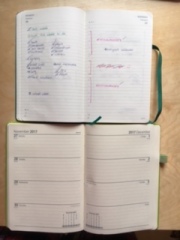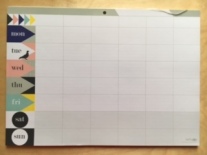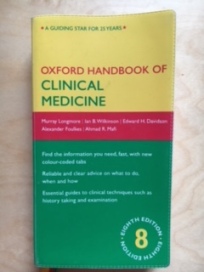I often get asked by students in lower years how I found time to manage my work and social life during medical school. Not going to lie it is very difficult to get enough revision done during Medical School and still feel like you are living a (reasonably) normal life.
This blog post is centred around how I managed my work throughout the year to keep on top of everything (how I revised coming up to exam season I will be writing about in a future blog).
Visualise your time
I find writing everything out in multiple colours is the best way for me to manage my time. I actually use multiple planners to sort everything out.
I usually make a wall calendar out of a weekly planner sheet. This then I can write on the big things for the next few months e.g. when I have a frisbee tournament, Birthdays etc.
I have a week to view diary that I keep with me at all times and this is where I write down the timetable for the week e.g. when and where my clinics are, Lectures etc.

I have a 2-day to view diary also where I can plan my individual days in
30 min intervals. What I tend to actually do with this planner is write down my days to-do list rather than using the specific time slots.
This might seem like rather a lot of planners but actually I find if I write down everything I need in this way I don’t miss anything and I am actually more productive.
Little and often
So if you have spent any time at Medical School you will have an appreciation of just how much there is to learn! It is possible to get through with just a mass cram session right before each exam (but I really would not recommend this!). The best thing to do is to revise little and often, I would try and get at least one thing done every day, even if it’s just to read one section of a textbook or to do 50 SBA questions- I lived on Pass Medicine.
I would often find that I had no motivation to do any revision, especially after a long day of work, so the trick is to find something to motivate you into doing something. I found treating myself with an episode (or 5) of Greys Anatomy if I managed to get an hour of revision in first was a useful goal. I also (sad I know) would use Greys to revise… As patients came in with weird and wonderful diseases I would look them up and have a little read of their presentation and management, this genuinely has helped me in the past when being quizzed by a consultant during a ward round.
Good Resources

So the most useful textbooks I used during Medical School were from the “Oxford Handbook” collection, specifically Oxford Handbook of Clinical Medicine and Oxford Handbook of Clinical Specialities.
Rather than buy multiple huge (very expensive) textbooks I tried to use internet resources as much
as possible. Patient.co.uk was the most useful place I supplemented my text book reading.
The TeachMeAnatomy and TeachMeSurgery websites have also been so helpful, the diagrams I found especially useful.
For testing myself I have had a PassMedicine account for the past 2 years (this does cost sadly but I found it so useful I would recommend paying). It was a great way to revise a topic you had learnt that week or sometimes if I really couldn’t make myself do proper revision I could use it as a bit of passive learning.
Setting out notes
So during clinical years I decided to hand write all my notes. This was a decision I made to try and make the process more active, I found if I types notes on my laptop I wouldn’t be giving it my full attention and I skipped corners by copying and pasting diagrams etc. When I hand wrote notes it meant I had to draw it all myself which helped me understand the content.
I found an A4 page per disease was a good marker. If I was writing much more than this I was going into far too much detail. That is the difficulty when revising medicine-knowing how much depth to go into each topic with as you can very easily get bogged down.
I would start with a section on anatomy and/or pathophysiology depending on the topic and my previous knowledge. If I was already confidant with the pathophysiology behind the disease I wouldn’t bother to re-write it (e.g. Asthma as we did this so much during pre-clinical years I know it backwards).
Next came risk factors, classically who gets the disease: gender, ethnicity, age etc.
Signs and Symptoms were the next thing- I found this section the most important as our medical school wrote most of their exams as a clinical presentation of signs and symptoms and from that you would have to develop a diagnosis with correct investigations and management.
For the investigations section I would try and split this into: Bed side tests, Blood tests, imaging and other fancy investigations.
Management of the disease I would also split, usually into Non-pharmacology, Pharmacology and surgery, again this is how the medical school tend to structure our exams so revising like this was useful for answering their questions.
I would end the page with outcomes of the disease, especially in the life shortening diseases, and any additional information I felt was important to know for that disease.
This is how I would write notes throughout the year. I would then convert these notes into smaller flash cards as I come up to exam season but this will be covered in another blog post.
If you’ve made it this far… Well Done!! I hope you have found something useful to help you through the joy that is Medical School.
Dr H xx

Great one
LikeLike